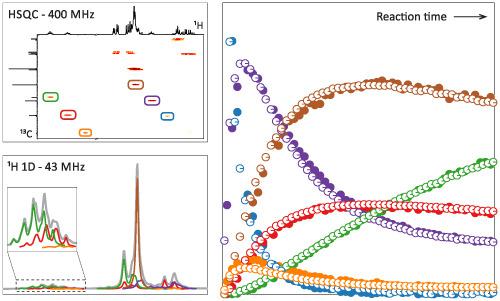当前位置:
X-MOL 学术
›
Magn. Reson. Chem.
›
论文详情
Our official English website, www.x-mol.net, welcomes your
feedback! (Note: you will need to create a separate account there.)
A comparison of non‐uniform sampling and model‐based analysis of NMR spectra for reaction monitoring
Magnetic Resonance in Chemistry ( IF 1.9 ) Pub Date : 2020-09-28 , DOI: 10.1002/mrc.5095 Ellen Steimers 1 , Yevgen Matviychuk 2 , Anne Friebel 1 , Kerstin Münnemann 1 , Erik von Harbou 1, 3 , Daniel J Holland 2
Magnetic Resonance in Chemistry ( IF 1.9 ) Pub Date : 2020-09-28 , DOI: 10.1002/mrc.5095 Ellen Steimers 1 , Yevgen Matviychuk 2 , Anne Friebel 1 , Kerstin Münnemann 1 , Erik von Harbou 1, 3 , Daniel J Holland 2
Affiliation

|
NMR spectroscopy is widely used for applications in the field of reaction and process monitoring. When complex reaction mixtures are studied, NMR spectra often suffer from low resolution and overlapping peaks, which places high demands on the method used to acquire or to analyze the NMR spectra. This work presents two NMR methods that help overcome these challenges, 2D non-uniform sampling (NUS) and a recently proposed model-based fitting approach for the analysis of 1D NMR spectra. We use the reaction of glycerol with acetic acid as it produces five reaction products that are all chemically similar, and hence challenging to distinguish. The reaction was measured on a high-field 400~MHz NMR spectrometer with a 2D NUS-HSQC and a conventional 1D1 H NMR sequence. We show that comparable results can be obtained using both 2D and 1D methods, if the 2D volume integrals of the 2D NUS-HSQC NMR spectra are calibrated. Further, we monitor the same reaction on a 43~MHz benchtop NMR spectrometer and analyse the acquired 1D1 H NMR spectra with the model-based approach and with partial least-square regression (PLS-R), both trained using a single, calibrated data set. Both methods achieve results that are in good quantitative agreement with the high field data. However, the model-based method was found to be less sensitive to the training data set used than PLS-R, and hence was more robust when the reaction conditions differed from that of the training data.
中文翻译:

用于反应监测的 NMR 光谱的非均匀采样和基于模型的分析的比较
核磁共振光谱广泛用于反应和过程监测领域的应用。在研究复杂的反应混合物时,NMR 光谱通常会遇到低分辨率和重叠峰的问题,这对用于获取或分析 NMR 光谱的方法提出了很高的要求。这项工作提出了两种有助于克服这些挑战的 NMR 方法,即 2D 非均匀采样 (NUS) 和最近提出的用于分析 1D NMR 光谱的基于模型的拟合方法。我们使用甘油与乙酸的反应,因为它会产生五种化学性质相似的反应产物,因此很难区分。该反应在高场 400MHz NMR 光谱仪上测量,具有 2D NUS-HSQC 和常规 1D1 H NMR 序列。我们表明使用 2D 和 1D 方法可以获得可比较的结果,如果 2D NUS-HSQC NMR 光谱的 2D 体积积分已校准。此外,我们在 43 MHz 台式 NMR 光谱仪上监测相同的反应,并使用基于模型的方法和偏最小二乘回归 (PLS-R) 分析获取的 1D1 H NMR 光谱,两者均使用单个校准数据进行训练放。这两种方法都获得了与高场数据具有良好定量一致性的结果。然而,发现基于模型的方法对使用的训练数据集不如 PLS-R 敏感,因此当反应条件与训练数据不同时更加稳健。我们在 43 MHz 台式 NMR 光谱仪上监测相同的反应,并使用基于模型的方法和偏最小二乘回归 (PLS-R) 分析获取的 1D1 H NMR 光谱,两者均使用单个校准数据集进行训练。这两种方法都获得了与高场数据具有良好定量一致性的结果。然而,发现基于模型的方法对使用的训练数据集不如 PLS-R 敏感,因此当反应条件与训练数据不同时更加稳健。我们在 43 MHz 台式 NMR 光谱仪上监测相同的反应,并使用基于模型的方法和偏最小二乘回归 (PLS-R) 分析获取的 1D1 H NMR 光谱,两者均使用单个校准数据集进行训练。这两种方法都获得了与高场数据具有良好定量一致性的结果。然而,发现基于模型的方法对使用的训练数据集不如 PLS-R 敏感,因此当反应条件与训练数据不同时更加稳健。
更新日期:2020-09-28
中文翻译:

用于反应监测的 NMR 光谱的非均匀采样和基于模型的分析的比较
核磁共振光谱广泛用于反应和过程监测领域的应用。在研究复杂的反应混合物时,NMR 光谱通常会遇到低分辨率和重叠峰的问题,这对用于获取或分析 NMR 光谱的方法提出了很高的要求。这项工作提出了两种有助于克服这些挑战的 NMR 方法,即 2D 非均匀采样 (NUS) 和最近提出的用于分析 1D NMR 光谱的基于模型的拟合方法。我们使用甘油与乙酸的反应,因为它会产生五种化学性质相似的反应产物,因此很难区分。该反应在高场 400MHz NMR 光谱仪上测量,具有 2D NUS-HSQC 和常规 1D1 H NMR 序列。我们表明使用 2D 和 1D 方法可以获得可比较的结果,如果 2D NUS-HSQC NMR 光谱的 2D 体积积分已校准。此外,我们在 43 MHz 台式 NMR 光谱仪上监测相同的反应,并使用基于模型的方法和偏最小二乘回归 (PLS-R) 分析获取的 1D1 H NMR 光谱,两者均使用单个校准数据进行训练放。这两种方法都获得了与高场数据具有良好定量一致性的结果。然而,发现基于模型的方法对使用的训练数据集不如 PLS-R 敏感,因此当反应条件与训练数据不同时更加稳健。我们在 43 MHz 台式 NMR 光谱仪上监测相同的反应,并使用基于模型的方法和偏最小二乘回归 (PLS-R) 分析获取的 1D1 H NMR 光谱,两者均使用单个校准数据集进行训练。这两种方法都获得了与高场数据具有良好定量一致性的结果。然而,发现基于模型的方法对使用的训练数据集不如 PLS-R 敏感,因此当反应条件与训练数据不同时更加稳健。我们在 43 MHz 台式 NMR 光谱仪上监测相同的反应,并使用基于模型的方法和偏最小二乘回归 (PLS-R) 分析获取的 1D1 H NMR 光谱,两者均使用单个校准数据集进行训练。这两种方法都获得了与高场数据具有良好定量一致性的结果。然而,发现基于模型的方法对使用的训练数据集不如 PLS-R 敏感,因此当反应条件与训练数据不同时更加稳健。











































 京公网安备 11010802027423号
京公网安备 11010802027423号